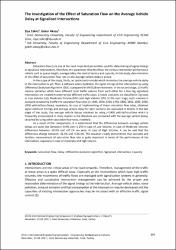| dc.contributor.author | Çakıcı, Ziya | en_US |
| dc.contributor.author | Aksoy, Göker | en_US |
| dc.date.accessioned | 2022-11-04T18:03:56Z | |
| dc.date.available | 2022-11-04T18:03:56Z | |
| dc.date.issued | 2021-12-18 | |
| dc.identifier.citation | Çakıcı, Z. & Aksoy, G. (2021). The investigation of the effect of saturation flow on the average vehicle delay at signalized intersections. Paper presented at the IES 2021 – International Engineering Symposium, 204-212. | en_US |
| dc.identifier.isbn | 9786057385895 | |
| dc.identifier.uri | https://hdl.handle.net/11729/5114 | |
| dc.description.abstract | Saturation flow (s) is one of the most important parameters used for determining of signal timings at signalized intersections. Therefore, this parameter directly affects the various intersection performance criteria such as queue length, average delay, the level of service and capacity. In this study, determination of the effect of saturation flow rate on the average vehicle delay is aimed. In the scope of the study, firstly, an optimization model which minimizes the average vehicle delay at the intersection is set. Then, a software which optimizes the signal timings at the intersection by using Differential Evolution Algorithm (DEA) is prepared in MATLAB environment. In the second stage, 15 traffic volume scenarios which have different total traffic volume from each other for a four-leg signalized intersection are created in order to test different traffic cases. Created scenarios are classified in 3 groups as Low Volume (LV), Moderate Volume (MV) and High Volume (HV). In the next stage, each scenario is analyzed considering 9 different saturation flow rates (s=1600, 1650, 1700, 1750, 1800, 1850, 1900, 1950, 2000 vehicle/hour/lane), separately. In case of implementing of these saturation flow rates, obtained signal optimum timings and average vehicle delay for each scenario are evaluated in details. In the last stage of the study, the average vehicle delays obtained by using s=1800 vehicle/hour/lane which is frequently encountered in many studies in the literature are compared with the average vehicle delays obtained by using other saturation flow rates, relatively. As a result of the comparisons, it is determined that the differences between average vehicle delays are quite low (between -0.9% and +1.2%) in case of Low Volume. In case of Moderate Volume, differences between -20.8% and +37.2% are seen. In case of High Volume, it can be said that the differences change between -41.4% and +116.3%. This situation clearly demonstrate that accurate and faultless measurement of saturation flow rate is quite important in terms of the performance of the intersection, especially in case of moderate and high volume. | en_US |
| dc.language.iso | en | en_US |
| dc.publisher | Izmir Democracy University | en_US |
| dc.relation.ispartof | IES 2021 – International Engineering Symposium | en_US |
| dc.rights | info:eu-repo/semantics/openAccess | en_US |
| dc.subject | Saturation flow | en_US |
| dc.subject | Delay | en_US |
| dc.subject | Differential evolution algorithm | en_US |
| dc.subject | Signalized intersection | en_US |
| dc.subject | Capacity | en_US |
| dc.title | The investigation of the effect of saturation flow on the average vehicle delay at signalized intersections | en_US |
| dc.type | Conference Object | en_US |
| dc.description.version | Publisher's Version | en_US |
| dc.department | Işık Üniversitesi, Mühendislik ve Doğa Bilimleri Fakültesi, İnşaat Mühendisliği Bölümü | en_US |
| dc.department | Işık University, Faculty of Engineering and Natural Sciences, Department of Civil Engineering | en_US |
| dc.authorid | 0000-0003-4592-7048 | |
| dc.authorid | 0000-0003-4592-7048 | en_US |
| dc.identifier.startpage | 204 | |
| dc.identifier.endpage | 212 | |
| dc.peerreviewed | Yes | en_US |
| dc.publicationstatus | Published | en_US |
| dc.relation.publicationcategory | Konferans Öğesi - Ulusal - Kurum Öğretim Elemanı | en_US |
| dc.institutionauthor | Aksoy, Göker | en_US |


















